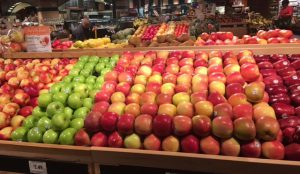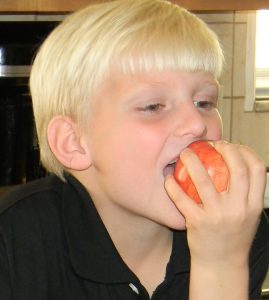by Laurie Osgood | Oct 26, 2017

Apples are an ancient fruit, grown for thousands of years, and belong to the Rose family of plants. The Rose family also includes plums, raspberries, cherries, peaches, pears, and almonds.
According to Professor Peter C. Andersen, UF/IFAS Horticultural Sciences Department at the North Florida Research and Education Center in Quincy, the basics of apple growing haven´t changed much over the centuries. Although many homeowners in north Florida can grow apple trees, there is little potential for establishment of commercial apple orchards in Florida. Andersen says apples are difficult to grow in north Florida due to high rainfall, humidity, and insects during the apple-ripening season, which is late May through August. Apples need a chill period in order to set buds in the spring. Without a sufficient chill period, the apple tree will not cultivate. For more information on Florida apple varieties, check out Low-Chill Apple Cultivars for North Florida and North Central Florida.
Luckily, there are more than 8,000 varieties of apples grown worldwide, so you can still enjoy a selection of apples in north Florida, even if you aren’t able to grow them yourself.
Fun Apple Facts:
- Apples are very nutritious, especially when you eat the whole apple. The majority of the apple’s nutrients are in its skin.
- Apples are a good source of fiber and vitamin C and do not contain sodium, fat, or cholesterol.
- Apples ripen much faster at room temperature than if they are refrigerated.
- It takes about 36 apples to create one gallon of apple cider.
Apple Varieties:
Every type of apple has a distinct color, texture, and taste. There are more than 8,000 variations of apples grown worldwide. Here are some of the more well-known apples that are grown in the United States:
| Red Delicious |
This apple is grown in Iowa and is known for its deep red color and mild sweetness. The Red Delicious apple is finest when eaten whole or chopped up into salads. |
| Granny Smith |
This variety has a thick, green exterior with a sour taste. It is firm, crisp, and juicy inside and is best used for baking into pies and other baked goods. |
| Gala |
This variety has a waxy red and yellow skin with a golden interior. Its tart taste is ideal for baking or just eating. |
| McIntosh |
This apple grows abundantly in New England. McIntosh apples are crisp and juicy at their peak, but tend to soften quickly. This variety can be eaten off the tree or made into apple cider. |
| Golden Delicious |
This variety has a soft yellow skin and sweet flavor. This is considered an all-purpose apple that is ideal for snacking and cooking. |
| Empire: |
Empire apples are named for its home state of New York and is a mixture of a red delicious and a McIntosh apple. The Empire apple is crunchy and has a sweet taste, however, its texture changes quickly with extended storage, so it’s best eaten at its peak of freshness. |
Cooper, Emily. “Apples, a Bushel and a Peak of Flavor.” Food and Nutrition, 2017, pp. 28–29.
There are many other varieties of apples, and all are incredibly good for you. For the greatest benefits, eat the whole fruit — both skin and flesh.
To learn more about apples and their health benefits and healthy eating, please visit UF/IFAS Extension Solutions for Your Life or the USDA SNAP-Ed Connection.
by Amy Mullins, PhD, RDN | Oct 26, 2017
 We all have family traditions that make our holiday celebrations special. From your great-great-grandma’s sweet potato casserole or pecan pie, to your mother-in-law’s sausage stuffing or decadent plum pudding, there’s one thing that always seems to be a common factor among traditional holiday dishes: a massive amount of, fat, sugar, salt, and calories!
We all have family traditions that make our holiday celebrations special. From your great-great-grandma’s sweet potato casserole or pecan pie, to your mother-in-law’s sausage stuffing or decadent plum pudding, there’s one thing that always seems to be a common factor among traditional holiday dishes: a massive amount of, fat, sugar, salt, and calories!
It’s not only a single meal but rather an entire season of parties, events, gatherings festivities, and unhealthy choices that add up to that holiday weight gain we resolve to lose when January rolls around. As the holiday season begins its rapid approach, take time and consider those past eating habits that set your new year off on the wrong foot. Why not make a resolution now to eat healthier this holiday season?
Just a few simple strategies can help make the difference and keep those unwanted pounds away. Here are some suggestions:
- Don’t skip meals. Eating healthy on a regular basis will keep you from overindulging at holiday gatherings.
- Use smaller plates for meals and gatherings and be mindful of portions
- Choose more vegetables and smaller helpings of entrees and desserts
- Drink more water and minimize alcoholic drinks and eggnog
- Make healthier recipe ingredient substitutions when cooking and baking (Mayo Clinic):
- Instead of heavy cream, use fat free half and half or evaporated skim milk
- Instead of bacon, try Canadian bacon, turkey bacon or smoked turkey
- Decrease sugar in baked goods by half and add vanilla, nutmeg, or cinnamon to intensify sweetness
- Substitute applesauce or prune puree for half of the butter, shortening, or oil
- Use two egg whites or ¼ cup egg substitute for each whole egg
- Replace salt with fresh or dried herbs and spices.
We can all still experience the joy of the holiday season, without making food the focus. Make a resolution to be mindful and eat healthier this holiday season, and your waistline will thank you.
Some additional links that you may find helpful:
https://healthyforgood.heart.org/eat-smart/articles/holidays-healthy-eating-guide
https://www.cdc.gov/features/HealthyResolutions/
https://choosemyplate-prod.azureedge.net/sites/default/files/printablematerials/2013-HolidayMakeover.pdf
https://www.mayoclinic.org/healthy-lifestyle/nutrition-and-healthy-eating/in-depth/healthy-recipes/art-20047195?p=1
by Dorothy C. Lee | Oct 26, 2017
 Some 30 million Americans have been diagnosed with diabetes this year. How will their lives be affected? Diabetes does mean some big changes but you may be surprised how much diet flexibility remains.
Some 30 million Americans have been diagnosed with diabetes this year. How will their lives be affected? Diabetes does mean some big changes but you may be surprised how much diet flexibility remains.
The human body is a marvelous machine, made up of many complex systems. When everything runs smoothly, we are “healthy”. Diabetes is an example of what happens when things don’t work exactly as they should. People with diabetes cannot properly use glucose, also called blood sugar, the cells energy source. Some people make no insulin, which regulates blood glucose by helping it enter the cells. Other people produce too little insulin, or have trouble using the insulin they make, or both.
The exact cause of diabetes is unknown, but if you have a family history of diabetes, you are at great risk. The ADA estimates that almost half of all people with diabetes don’t know they have the disease. Some people ignore their symptoms until they have medical complications.
Some of the warning signs of diabetes may be symptoms of excessive thirst, unusual hunger, slow healing of infections, constant urination, blurred vision, weakness and fatigue. Recurring of these symptoms may signal the need to consult your physician.
A diagnosis of diabetes doesn’t’ have to mean dietary deprivation and boredom. The key dietary words are; low-fat, high-fiber, low-sodium, well-balanced and reduced sugar.
Exercise is another important factor in diabetes management for two reason. Active people have an easier time losing weight which is important for controlling glucose levels. Exercise also promotes the cells ability to use glucose, which in turn reduces the amount of glucose in the body to more favorable levels.
Stress reduction is an important part of a wellness program. Feeling stressed out, uptight, and edgy strains the entire body. We may not have control over the sources of stress in our life; therefore, change the way you react to life’s stressors. Physical exercise is one of the best stress reducers. Don’t take on more than you can handle. Use support systems, reach out to family and friends.
Diabetes affects many people and can have very serious consequences, but the good news is that your health habits can help prevent diabetes or reduce its impact on your health. A healthy lifestyle can help reduce the risks of disease that are often a complication of diabetes.

by Melanie Taylor | Oct 16, 2017

Make Halloween a fun and safe night for children and adults alike.
From candy to pumpkins to the costumes, Halloween is a fun-filled time for kids and adults alike. However, it can pose dangers. To help make this year’s trick-or-treat a safe and fun time, follow these simple safety tips compiled by the American Academy of Pediatrics.
CREATIVE COSTUMES:
Plan costumes that are bright and reflective. Make sure shoes fit well and costumes are short enough to prevent tripping, entanglement, or contact with flames.
Consider adding reflective tape or striping to costumes and trick-or-treat bags for greater visibility.
Because masks can limit or block eyesight, consider non-toxic makeup and decorative hats as safer alternatives. Hats should fit properly to prevent them from sliding over eyes. The makeup should be tested on a small patch of skin ahead of time to ensure there are no unpleasant allergies on the big night.
When shopping for costumes, wigs, and accessories, look for and purchase those with a label clearly indicating they are “flame resistant.”
If a sword, cane, or stick is a part of your child’s costume, make sure it is not sharp or long. A child may be easily hurt by the accessories if he/she stumbles or trips.
Do not use decorative contact lenses without an eye examination and a prescription from an eye care professional. While the packaging on decorative lenses will often make claims such as “one size fits all,” or “no need to see an eye specialist,” obtaining decorative contact lenses without a prescription is both dangerous and illegal. This can cause pain, inflammation, and serious eye disorders and infections, which may lead to permanent vision loss.
Review with children how to call 911 if they ever have an emergency or become lost.
PUMPKIN CARVING TIME:
Small children should never carve pumpkins. Children can draw a face with markers. Then adults can do the cutting.
Consider using a flashlight or glow stick instead of a candle to light your pumpkin. If you do use a candle, a votive candle is safest.
Candlelit pumpkins should be placed on a sturdy table, away from curtains and other flammable objects, and not on a porch or any path where visitors may pass close by. They should never be left unattended.
HOME SAFETY:
To keep homes safe for visiting trick-or-treaters, parents should remove from the porch and front yard anything a child could trip over such as garden hoses, toys, bikes, and lawn decorations.
Adults should check outdoor lights and replace burned-out bulbs.
Wet leaves and debris should be swept from sidewalks and steps.
Restrain pets so they do not jump on or bite a trick-or-treater.
TRICK-OR-TREAT TIME:
A responsible adult should always accompany young children during their neighborhood trick-or-treating.
Obtain flashlights with fresh batteries for all children and adults.
If your older children are going alone, plan and review the route that is acceptable to you. Agree on a specific time when they should return home.
Only go to homes with a porch light on and never enter a home or car for a treat.
Because pedestrian injuries are the most common injuries to children on Halloween, remind Trick-or-Treaters to:
- Stay in a group and communicate where they will be going.
- Remember reflective tape for costumes and trick-or-treat bags.
- Carry a cellphone for quick communication.
- Remain on well-lit streets and always use the sidewalk.
- If no sidewalk is available, walk at the far edge of the roadway facing traffic.
- Never cut across yards or use alleys.
- Only cross the street as a group in established crosswalks (as recognized by local custom). Never cross between parked cars or out of driveways.
- Do not assume the right of way. Motorists may have a hard time seeing Trick-or-Treaters.
- Just because one car stops does not mean others will!
- Law enforcement authorities should be notified immediately of any suspicious or unlawful activity.
HEALTHY HALLOWEEN TIPS:
A good, healthy dinner prior to parties and trick-or-treating will discourage children from filling up on Halloween treats.
Consider purchasing non-food treats for those who visit your home, such as coloring books, stickers, or pens and pencils.
Wait until children are home to sort and check treats. Though tampering is rare, a responsible adult should closely examine all treats and throw away any spoiled, unwrapped or suspicious items.
Try to ration treats for the days and weeks following Halloween to prevent overindulging, which will lead to a stomachache and ruin the night’s fun.
Make sure the Halloween night is fun and safe with the suggested tips above. These tips will help guarantee you all a ghoulishly good time.
Source: American Academy of Pediatrics
by Ginny Hinton | Aug 18, 2017

With kids back in school, moms face a set of challenges that somehow seem new every year. One of those challenges is what to feed kiddos who race in the door hungry after a long day in the classroom. As a savvy mom, you know that snacks can help your kids meet their nutritional needs – as long as you pick the right ones. That’s where it can get a bit tricky because in addition to being healthful, the snacks need to be loaded with kid appeal plus be quick and easy to grab. Try some of the following ideas from the different food groups to create a snack that will give your kids calories (energy), meet their nutritional needs, and taste great as well!
• Banana Tortilla Treat – Grab a whole wheat tortilla, spread with peanut butter and sprinkle with low-fat granola. Put a peeled banana on top and roll the tortilla.
• Combo-licious – Top a scoop of cottage cheese with canned fruit. Choose peaches, pears, mango, pineapple or fruit cocktail.
• Wrap It – Spread fresh hummus on a whole wheat tortilla. Add thinly sliced carrots, zucchini, cucumber, or whatever veggie your kids prefer. Roll it up and go!
Feeling rushed in the afternoons? Plan ahead and create a healthy snack shelf at eye level in your pantry and in your refrigerator for kids to grab and go. You might try the following:
• String cheese and a small can of fruit.
• Fat free or 1% flavored milk (chocolate or strawberry)
• Pre-cut raw veggies (celery sticks, baby carrots, cucumber slices) in zipped baggies beside low-fat yogurt dip, cottage cheese or hummus.
• Snack-sized applesauce
• Trail mix with nuts and dried fruit
• Flavored rice cakes with peanut butter to spread
• Microwave popcorn
• Whole-grain crackers on the shelf and sliced cheese in the ‘fridge
With just a little planning, you can avoid snack-time stress and help your kids learn healthy eating habits at the same time.
For more ideas, check out these snack tips for parents. 10 Choose My Plate Snack Tips






